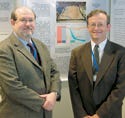Life Recovery Systems: Lean and Mean Structure for Quick Approval
June 1, 2007
OUTSTANDING QUALITY AND REGULATORY TEAMS
|
How do you go from being a start-up with a design concept to an OEM with a fully functioning quality system in just three years? Life Recovery Systems (Kinnelon, NJ) did it by finding experienced people who knew how to get the right things done fast.
“It only took three years between getting a [National Institutes of Health] grant and receiving FDA clearance,” says John DiLiddo, the firm's vice president of marketing and business development. “That was the fastest [NIH] had ever seen.”
Life Recovery Systems is a classic doctor-founded start-up. Robert Freedman, MD, had noticed that patients immersed in ice water experienced a full recovery after rewarming, even if their hearts had stopped. He then deduced that ice-water immersion or other methods of inducing hypothermia could prevent brain damage in patients with oxygen deprivation.
But immersion in ice water is messy, impractical, and possibly unsafe for caregivers. Freedman spent 14 years designing the ThermoSuit System, a software-driven noninvasive skincontact product that contains circulating ice water. It cools the patient in minutes rather than the hours it takes with a cooling blanket or gel pad.
|
Founders Robert Freedman and Robert Schock. |
In 2003, Freedman formed Life Recovery Systems with Robert Schock, PhD, a biomedical engineer who, along with colleague Marc Coté, designed the system. A year later, the firm was ready to build a quality system and prepare a regulatory submission.
A much larger competitor took four years to receive FDA clearance, a CE mark, and to qualify a quality system. But it took Life Recovery Systems about half that time. (It registered its quality system in March 2006, received 510(k) clearance in September 2006, and at press time expected a CE mark to be issued in May.)
The key to getting everything done so rapidly but thoroughly was to build a team of employees and consultants who had experience. “We all knew one another, and we all had a lot of experience in the device industry, working on many complex products,” DiLiddo says.
Having a small team worked to the firm's advantage, because there were no layers of bureaucracy to slow things down, says Dan Whelan, director of quality management. “Our structure is lean and mean,” he says. “All of us came from large corporations, and we all had less-than-positive experiences there. But here we were able to do everything we needed to do without having to build a bureaucracy that would weigh things down. We were not slowed down by piles of paperwork.” Whelan says that because he had 25 years of experience, the others trusted him to design a quality system that would work for making the device, and he faced few obstacles.
The firm also added suppliers Ximedica LLC (Providence, RI), Nexcore Technology Inc. (Hackensack, NJ), and Dielectrics Industries (Chicopee, MA) to the team. Their expertise in designing and manufacturing components proved crucial in setting up a quality system that met regulatory requirements. (Life Recovery Systems found some partners at the Medical Design & Manufacturing East trade show in New York City.)
The lean structure helped when putting together the regulatory application, says Whelan. “To get all the approvals we needed to put something in the application, we had to run it by three or four people, not 10 or 12.”
Yet the application did not suffer in terms of thoroughness, nor did the company in terms of preparedness. Despite the complexity of the product and FDA's decision to create a new classification for it, the 510(k) was submitted in April 2006 and cleared six months later, with only one round of extra questions. There were several mitigating factors. One was the risk-reduction efforts during the design and development process. These were well documented in the submission, so FDA didn't need to be concerned about risk assessment and risk management issues. Another was the team's ability to correlate the results of animal studies to a human model.
|
Dan Whelan, Robert Schock, John DiLiddo, and Marc Coté set up a test of a competitive product. |
“The prep time for the submission was key,” says David Robson, development director of Ximedica. “Taking the extra time to properly strategize early in the development process allowed the submission, once ready, to fly through review. It's the classic lesson of taking the time to plan in order to save months and months of waiting and adjusting later. The basic submission strategy did not change at all once the development process was under way.”
The agency declared the ThermoSuit System substantially equivalent to a cooling blanket. Today, the technology is attracting a lot of notice in the media, and Life Recovery Systems is about to scale up production. “We're ready to go,” says Whelan. “I don't think we would have been had we been a big company.”
The Life Recovery Systems Team
Marc Coté, director, engineering
John DiLiddo, vice president, marketing and business development
Robert Freedman, founder
William Ohley, consultant
Brandi Ruffalo, consultant
Robert Schock, vice president, R&D
Russell Van Zandt, consultant
Dan Whelan, director, quality management
More Teams
Copyright ©2007 Medical Device & Diagnostic Industry
About the Author(s)
You May Also Like




.png?width=300&auto=webp&quality=80&disable=upscale)
